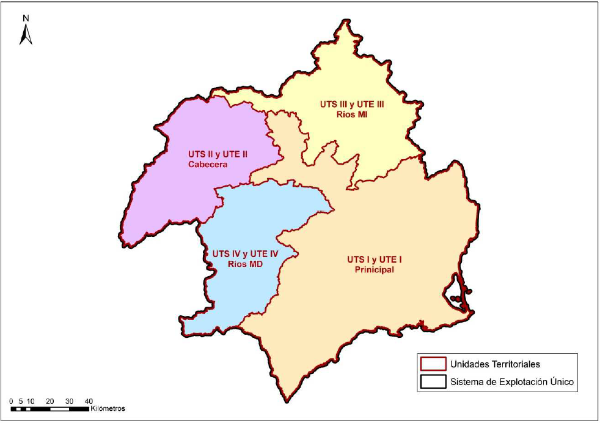The previous Drought Plan only contemplated three indices that reflected scarcity in the basin: the basin system state index; the state index of the transfer system; and the global state index. In all three cases, the indices were calculated by normalizing between 0 and 1 of an indicator that, in different proportions, weighted the stocks at day 1 of each month in each system and the accumulated year-on-year contributions. The indicator for the global index was calculated using a weighted sum of both indicators, and the global index was calculated using the same formula as the indices for the two subsystems.
Among the main novelties of the new PES, regarding the characterization of drought situations are:
- The basin is divided into four territorial units of drought (UTS) and four territorial units of scarcity (UTE), which fully coincide. The four territorial units are:
- Main system
- Header
- Rivers Left Bank
- Rivers Right bank

- A drought index will be calculated for each territorial unit, which will be a normalization of the drought index recommended by the World Meteorological Organization (WMO): the SPI (Standardized Precipitation Index). The time step chosen for the SPI to be used in the 4 territorial units is 9 months, as it best reflects the behavior of flows (for the purpose of complying with ecological flows).
- The indices of each UTS are combined in a weighted manner (depending on the length of the water bodies for which an ecological flow has been established) to establish a Global drought index for the Segura basin.
- The drought index is used to diagnose the situation of prolonged drought , which occurs when the index of a UTS or the global falls below 0:30. In this situation, for the masses of that UTS (or of the entire basin, if applicable) that have an established ecological flow, the compliance regime for this will be relaxed. The forecasts of tolerance to the temporary deterioration of the state of the water bodies due to natural circumstances will also be activated. As a particularity, in the case of the UTS main system, the drought index of the UTS header will be used to determine the drought prolonged in the masses of the main axis of the Segura river ; and its own drought index will be used to determine the prolonged drought in the rest of the masses.
- Regarding the scarcity indexes, there are important novelties. For headwater and riverine joint ventures on the left and right banks, the scarcity indices will also be the nine-month SPI . On the other hand, for the UTE Main system, the scarcity index will be similar to the state indices that were calculated:
- Instead of moving averages, fixed thresholds of the value of the indicator will be used to determine the steps of a shortage phase(Normality>Prealert>Alert>Emergency) to another.
- Scarcity phase change thresholds of the index change. Before Prealert and Alert it was previously the value of 0'35 and now it becomes 0'30, while between Alert and Emergency it was 0'20 and it becomes 0'15. However, for these indices to reflect situations identical to those characterized in the past, the indicator thresholds that previously implied a value of 0.35 are now interpreted as 0.30, and the same is true for the other threshold.
- The previous global scarcity index weighted the indicators for the basin and transfer subsystems, and then used the formula to calculate the index; In the new PES, the indicators of the subsystems will not be used to calculate the global scarcity index, but their indices , and the weight will be 50% -50%.
- To declare an extraordinary drought , situations of ALERT due to shortage of the situation and PROLONGED DROUGHT due to drought must occur simultaneously. It can also be declared with an EMERGENCY situation due to shortage of the situation, although no prolonged drought is detected. The prolonged drought required in ALERT situations can occur either in the Segura area or in the headwaters of the Tagus. To assess whether this occurs at the head of the Tajo, the state indicators for the head of the Tajo contained in the new PES del Tajo will be used, which identifies an indicator essentially based on the contributions of the last three months to the Entrepeñas reservoirs and Buendía, normalized between 0-1 and with a weighting between reservoirs of 0.55 / 0.45.



